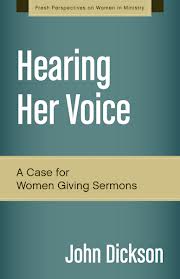Review: Hearing Her Voice: A Case for Women Giving Sermons
 Is there still a debate on whether, how and why women can, should be, and are in Christian ministry in Australian Anglicanism? Clearly there is still disagreement. Clearly there is still division on this topic. There is regularly yet another regurgitation of either rabid complementarianism or apopletic egalitarianism. But there hasn’t been much for a while that actually moves the debate on. Nothing that throws a corollary or implication or foundational concept into the ring which has yet to be considered.
Is there still a debate on whether, how and why women can, should be, and are in Christian ministry in Australian Anglicanism? Clearly there is still disagreement. Clearly there is still division on this topic. There is regularly yet another regurgitation of either rabid complementarianism or apopletic egalitarianism. But there hasn’t been much for a while that actually moves the debate on. Nothing that throws a corollary or implication or foundational concept into the ring which has yet to be considered.
Perhaps John Dickson has done it with his recent short book Hearing Her voice: A Case for Women Giving Sermons.
Dickson has one, precise, thing to say in his book. It is an interaction with that ever-perplexing verse from 1st Timothy (2:12) which states (to use the ESV) “I do not permit a woman to teach or to exercise authority over a man; rather, she is to remain quiet.” His one point is this – that there is nothing in that verse that prohibits a woman delivering that part of Christian services that we commonly call “the sermon.”
That’s it. He makes virtually no comment on issues such as headship, normative gender roles, or any other juicy parts of the topic. He simply has the view that when Paul writes to Timothy he is not talking about sermons, and therefore women need not be excluded from the pulpit.
It’s a small point that will scandalise many for either being too liberal or not liberal enough. Dickson seems to be aware of that, it is as if every second sentence is an appeal to “please listen to the one precise thing I am saying, not the things you think I might be saying.”
The value of the book, however, is in the methodology. The methodology is, you might say, very “Sydney.” It is deeply exegetical, using historical considerations to illuminate, not eradicate, semantic precision while articulately allowing “Scripture to interpret Scripture”, particularly within the Pauline corpus.
His argument is based on Paul’s precise semantics about “teaching”, “preaching”, “exhorting”, “evangelising”, “prophesying” and the like. His assertion is that the only thing prohibited for women is “teaching.” Moreover, he notes, that the “sermon” as we know it is most properly, in Paul’s terms, not teaching but exhorting, prophesying, or evangelising – activities that Paul not only allows for women but encourages for women.
For Dickson teaching is relegated to authoritive recollection and transmission of apostolic teaching – the oral canon that existed before the written one.
It’s an argument I haven’t seen much of before. It’s a worthy addition to the ongoing debate.
And there is some debate to be had – Dickson’s credentials can not be lightly dismissed and his exegesis is thorough. However, he refuses to further tread where angels have feared by not extrapolating or speculating further. He only defines the permissibility that he finds in Paul, he does not explain the prohibition on (the very specific) “teaching” nor does he explain the implications of that prohibition in terms of a robust and conclusive theology of gender.
Perhaps he will keep (and make) some friends in this ongoing debate that way – a debate which now has one more piece of required reading for all involved.


